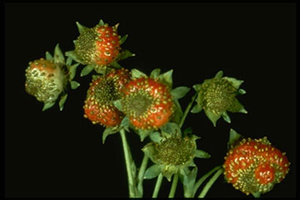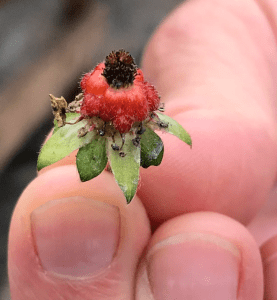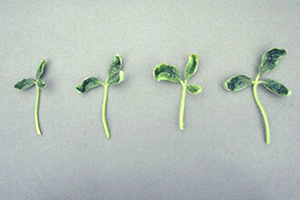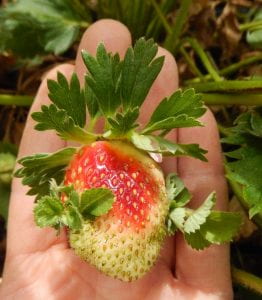The most common cause of nubby fruits is Tarnished Plant Bug feeding. However, frost injury, boron deficiency, poor pollination, and phyllody also cause deformed berries. Nubbiness caused by tarnished plant bugs almost always occurs at the distal end of the berry. Deformity from other causes is not limited to the distal end. Note: The variety ‘Delmarvel’ develops nubby ends because, under certain conditions, the distal pistils appear to be infertile.
Tarnished plant bug
Tarnished plant bug, Lygus lineolaris, feeds on the flowers, causing the berries to deform when they grow. Feeding by nymphs causes the most severe damage, and a threshold of one nymph per every two flower clusters is sufficient to warrant treatment.

Adult tarnished plant bugs overwinter and lay eggs, but they do minimal damage to strawberry flowers in spring. Nymphs cause the most injury. More tarnished plant bug information.

Frost injury
Light frost injury will sometimes cause deformed berries, but this is usually associated with blackened centers in at least some adjacent flowers. More frost damage information.



Boron deficiency
Boron is the most commonly deficient micronutrient in strawberry plantings as it is very prone to leaching. Boron deficiency causes many symptoms, but among the most obvious are deformed berries…

… asymmetrical leaves…


and stubby roots.

Suspected boron deficiencies can be verified with a foliar analysis done through Agro-One.
Poor pollination
Poorly pollinated berries tend to be small with a rough, dimpled, seedy appearance similar to that of boron deficiency. More strawberry pollination information.
Phyllody
Phyllody describes leaf-life structures developing in the place of fruit or flower parts. There are infectious and non-infectious causes of phyllody. Affected fruit are not marketable but fruit production rate is not reduced.

Non-infectious phyllody can be caused by excess chilling of transplants. Symptoms develop early in the season but resolve themselves later in the season. Removing deformed fruit early can help conserve root carbon reserves for the next flush of marketable fruit.
Infectious phyllody is caused by mycoplasma infection. Leafhoppers can spread various mycoplasmas throughout a planting during feeding. Aster yellows and green petal MLO are two mycoplasma-induced diseases that also cause phyllody.


